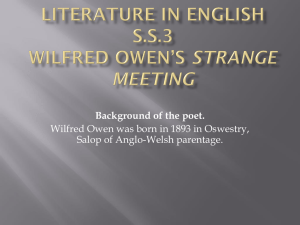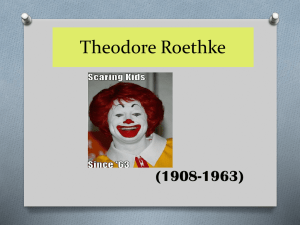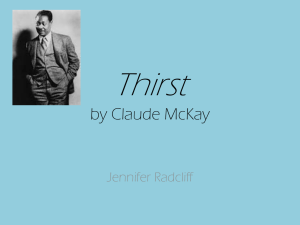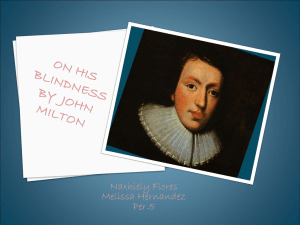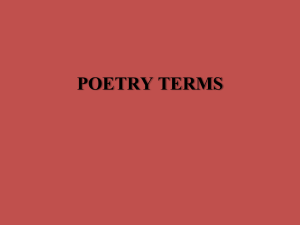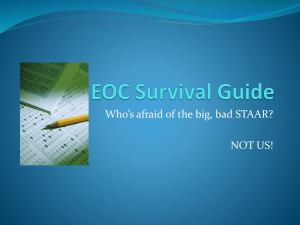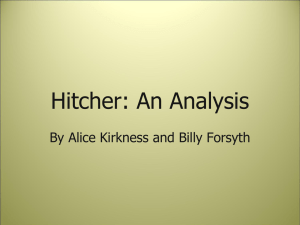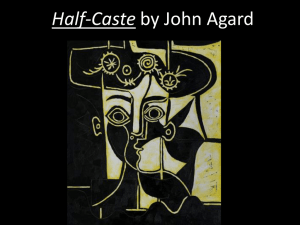Poetry revision 2014 NEW
advertisement
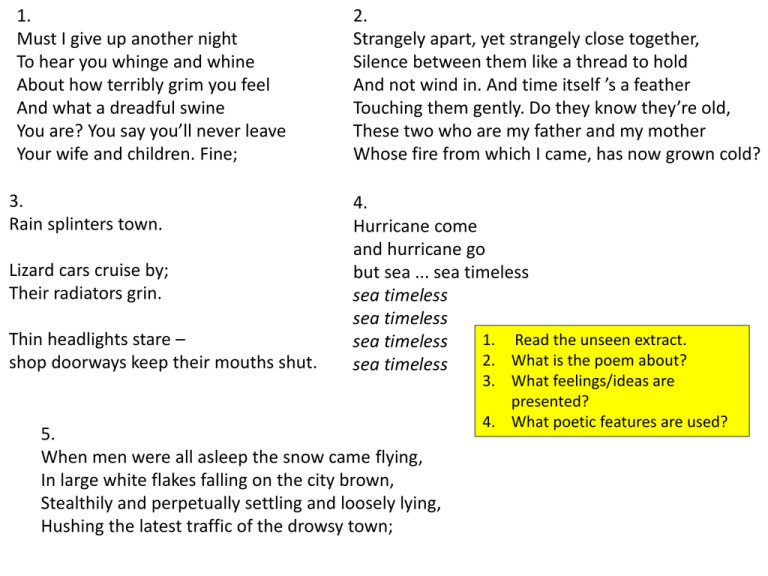
1. Must I give up another night To hear you whinge and whine About how terribly grim you feel And what a dreadful swine You are? You say you’ll never leave Your wife and children. Fine; 3. Rain splinters town. Lizard cars cruise by; Their radiators grin. Thin headlights stare – shop doorways keep their mouths shut. 2. Strangely apart, yet strangely close together, Silence between them like a thread to hold And not wind in. And time itself ’s a feather Touching them gently. Do they know they’re old, These two who are my father and my mother Whose fire from which I came, has now grown cold? 4. Hurricane come and hurricane go but sea ... sea timeless sea timeless sea timeless 1. Read the unseen extract. sea timeless 2. What is the poem about? sea timeless 5. When men were all asleep the snow came flying, In large white flakes falling on the city brown, Stealthily and perpetually settling and loosely lying, Hushing the latest traffic of the drowsy town; 3. What feelings/ideas are presented? 4. What poetic features are used? Poetry Revision 1. 2. 3. 4. To understand how to respond to the unseen question. To explore a poem for its main ideas. To explain the effect of poetic techniques. To identify differences in quality from a range of responses. What progress will look like… I am content if you know what to include in your unseen response. I am happy if you know what to include in your unseen response and can make multiple comments on a quote. I am ecstatic if you know what to include in your unseen response and can make multiple comments on a quote that are perceptive. 1. Explore how Vernon Scannell presents memories of his friends and stealing apples. 20 marks What is the key word in the question? What do you have to do? How do we respond to this question perceptively? How long should you spend? How much should you write? Unseen Band 4 13-16 • Assured understanding of the poem’s content/ideas. • Assured explanation of how the writer uses language, structure and form to present the poem’s content/ideas. • Pertinent textual reference to support response. *Purposeful organisation and assured communication of ideas. Spelling, punctuation and grammar are almost always accurate, With minimal errors. Band 5 17-20 • Perceptive understanding of the poem’s content/ideas. • Perceptive explanation of how the writer uses language, structure and form to present the poem’s content/ideas. • Convincing, relevant textual reference to support response. *Convincing organisation and sophisticated communication of ideas. Spelling, punctuation and grammar are consistently accurate. The Moment The moment when, after many years of hard work and a long voyage you stand in the centre of your room, house, half-acre, square mile, island, country, knowing at last how you got there, and say, I own this, is the same moment when the trees unloose their soft arms from around you, the birds take back their language, the cliffs fissure and collapse, the air moves back from you like a wave and you can't breathe. No, they whisper. You own nothing. You were a visitor, time after time climbing the hill, planting the flag, proclaiming. We never belonged to you. You never found us. It was always the other way round. Margaret Atwood 1. I give you an onion. Its fierce kiss will stay on your lips, possessive and faithful as we are, for as long as we are. 3. In every cry of every Man, In every Infant’s cry of fear, In every voice, in every ban, The mind-forg’d manacles I hear: 5. We chase misprinted lies We face the path of time And yet I fight And yet I fight This battle all alone No one to cry to No place to call home 2. The telephone shatters the night’s dark glass. I’m suddenly awake in the new year air And in the moment it takes a life to pass From waking to sleeping I feel you there. 1. Read the unseen extract. 2. What is the poem about? 3. What feelings/ideas are presented? 4. What poetic features are used? 4. I can teach yu of Timbuktu I can do more dan dance, I am not de problem I greet yu wid a smile Yu put me in a pigeon hole But I am versatile Poetry Revision 1. To understand how to respond to the unseen question. 2. To identify differences in quality from a range of responses. What progress will look like… I am content if you use the PEELP structure correctly. I am happy if you also make an attempt at being perceptive in your PEELP. I am ecstatic if you can rank responses on how perceptive they are. Perceptive Sensitive Insightful Sharp Unique Discerning Hurricane come and hurricane go but sea ... sea timeless sea timeless sea timeless sea timeless sea timeless Assured= Repetition = emphasises that the sea is important because it is ongoing and constant, suggesting its power. Perceptive = Repetition = emphasises that the sea is important because it is constant and relentless, this suggest the power of the sea and how it isn’t effected by time and circumstance. Success Criteria - PEELP 1. A point about the topic in the question. 2. A relevant quote. 3. Identify poetic devices and comment on their effect/meaning – multiple comments. What does the feature tell the reader about the topic? 4. How does the reader react? 5. Personal response – compliment, criticise, say how you feel. The Apple Raid Darkness came early, though not yet cold; Stars were strung on the telegraph wires; Street lamps spilled pools of liquid gold; The breeze was spiced with garden fires. 1. 4 ideas linked to memories or stealing apples. 2. Link your 4 ideas to 4 poetic features (at least one structural). 3. Personally respond to the 4 features. That smell of burnt leaves, the early dark, Can still excite me but not as it did So long ago when we met in the Park – Myself, John Peters and David Kidd. We moved out of town to the district where The lucky and wealthy had their homes With garages, gardens, and apples to spare Ripely clustered in the trees’ green domes. We chose the place we meant to plunder And climbed the wall and dropped down to The secret dark. Apples crunched under Our feet as we moved through the grass and dew. The clusters on the lower boughs of the tree Were easy to reach. We stored the fruit In pockets and jerseys until all three Boys were heavy with their tasty loot. Safe on the other side of the wall We moved back to town and munched as we went. I wonder if David remembers at all That little adventure, the apples’ fresh scent? Strange to think that he’s fifty years old, That tough little boy with scabs on his knees; Stranger to think that John Peters lies cold In an orchard in France beneath apple trees. Vernon Scannell 1. Explore how Vernon Scannell presents memories of his friends and stealing apples. 20 marks Group paragraphs Competition – Which group can write the best PEELP on the Apple raid question? 1 person is team leader – organises ideas 1 person is the writer – Neat! 1 person is responsible for making sure there are multiple comments and features identified. 1 person is responsible for the vocabulary. 1 person is responsible for the personal response. 1 person is responsible for checking its accuracy and whether it answers the question. This is about your best paragraph, your most perceptive work. Select the most interesting area of the poem to write about. 1. 2. 3. 4. 5. PEELP A point about the topic in the question. A relevant quote. Identify poetic devices and comment on their effect/meaning – multiple comments. What does the feature tell the reader about the topic? How does the reader react? Personal response – compliment, criticise, say how you feel. Being perceptive Sensitive Insightful Sharp Unique Discerning reminiscing Band 5 17-20 Success Criteria • Perceptive understanding of the poem’s content/ideas. • Perceptive explanation of how the writer uses language, structure and form to present the poem’s content/ideas. • Convincing, relevant textual reference to support response. *Convincing organisation and sophisticated communication of ideas. Spelling, punctuation and grammar are consistently accurate 1 person is team leader – organises ideas 1 person is the writer – Neat! 1 person is responsible for making sure there are multiple comments and features identified. 1 person is responsible for the vocabulary. 1 person is responsible for the personal response. 1 person is responsible for checking its accuracy and whether it answers the question Which group’s was the best? What were the weaknesses? What were the strengths? Group Evaluation What were the weaknesses? What were the strengths? Which one was better? The Rules of Unseen - PEELP. - 45 minutes – 10 reading/planning, 30 writing, 5 checking. - 4 paragraphs minimum. - Know the topic. - Comment on language and structure. - Personally evaluate or respond. The Rules of Unseen - PEELP. - 45 minutes – 10 reading/planning, 30 writing, 5 checking. - 4 paragraphs minimum. - Know the topic. - Comment on language and structure. - Personally evaluate or respond. Unseen Mock . Blackberry-Picking Late August, given heavy rain and sun For a full week, the blackberries would ripen. At first, just one, a glossy purple clot Among others, red, green, hard as a knot. You ate that first one and its flesh was sweet Like thickened wine: summer's blood was in it Leaving stains upon the tongue and lust for Picking. Then red ones inked up and that hunger Sent us out with milk cans, pea tins, jam-pots Where briars scratched and wet grass bleached our boots. Round hayfields, cornfields and potato-drills We trekked and picked until the cans were full Until the tinkling bottom had been covered With green ones, and on top big dark blobs burned Like a plate of eyes. Our hands were peppered With thorn pricks, our palms sticky as Bluebeard's. We hoarded the fresh berries in the byre. But when the bath was filled we found a fur, A rat-grey fungus, glutting on our cache. The juice was stinking too. Once off the bush The fruit fermented, the sweet flesh would turn sour. I always felt like crying. It wasn't fair That all the lovely canfuls smelt of rot. Each year I hoped they'd keep, knew they would not. Seamus Heaney 1. Explore how Seamus Heaney presents memories of blackberry picking. 20 marks 10 minutes reading and planning 30 minutes writing PEELP 5 minutes checking Multiple interpretations – What is this extract about? Which line is the most interesting? We penetrated deeper and deeper into the heart of darkness. It was very quiet there. At night sometimes the roll of the drums behind the curtain of trees would run up the river and remain sustained faintly, as if hovering in the air high over our heads, till the first break of day ... The dawn were heralded by a chill stillness; the wood-cutters slept, their fires burned low; the snapping of a twig would make you start. We were wanderers on a prehistoric planet ... But suddenly, as we struggled round a bend, there would be a glimpse of rush walls, of peaked grass-roof, a burst of yells, a whirl of black limbs, a mass of hands clapping, of feet stamping, of bodies swaying, of eyes rolling, under the droops of heavy and motionless foliage. What progress will look like… I am content if you can make key points about Our Sharpeville. I am happy if you can also link poetic features to the topic of the question. I am ecstatic if you can also perceptively explain the writer’s ideas and decide on the ‘best’ evidence to support your explanation. Poetry Revision 1. To understand how to respond to the first Anthology question. 2. To explore a poem for its main ideas. 3. To explain the effect of poetic techniques. Collection B: Clashes and Collisions 3 (a) Explore how the writer presents the violent events in ‘Our Sharpeville’. Use evidence from the poem to support your answer. (15) Answer 3(b)(i) OR 3(b)(ii) EITHER (b) (i) Compare how the writer of ‘Belfast Confetti’ explores different violent events from those in ‘Our Sharpeville’. Use evidence from the poems to support your answer. You may include material you used to answer 3(a). (15) OR (ii) Compare how the writers of ‘Our Sharpeville’ and one poem of your choice from the ‘Clashes and Collisions’ collection reflect on the effects of violence on society. Use evidence from the poems to support your answer. You may include material you used to answer 3(a). (15) (Total for Question 3 = 30 marks) Clashes and Collisions 3a Band 4 10-12 • Assured explanation of how the writer conveys ideas to create effect. • Relevant connection made between the topic and the presentation of ideas. • Pertinent textual reference to support response. Band 5 13-15 • Perceptive explanation of how the writer uses ideas to create effect. • Discriminating, relevant connection made between the topic and the presentation of ideas. • Convincing, relevant textual reference to support response. 3b Band 4 10-12 • Assured comparisons and links. • Pertinent evaluation of the different ways of expressing meaning and achieving effects. • The selection of examples is assured, appropriate and supports the points being made. Band 5 13-15 • Discriminating comparisons and links showing insight. • Perceptive evaluation of the different ways of expressing meaning and achieving effects. • The selection of examples is discriminating and fully supports the points being made. 3 a) Explore how the writer presents the violent events in ‘Our Sharpeville’. Use evidence from the poem to support your answer. I was playing hopscotch on the slate when the miners roared past in lorries, their arms raised, signals at a crossing their chanting foreign and familiar, like the call and answer of road gangs across the veld, building hot arteries from the heart of the Transvaal mine. I ran to the gate to watch them pass. And it seemed like a great caravan moving across the desert to an oasis I remembered from my Sunday school book: olive trees, a deep jade pool, men resting in clusters after a long journey, the danger of the mission still around them, and night falling, its silver stars just like the ones you got for remembering your Bible texts. Then my grandmother called from behind the front door, her voice a stiff broom over the steps: "Come inside; they do things to little girls." For it was noon, and there was no jade pool. Instead, a pool of blood that already had a living name and grew like a shadow as the day lengthened. The dead, buried in voices that reached my gate, the chanting man on ambushed trucks, these were not heroes in my town, but maulers of children, doing things that had to remain nameless. And our Sharpeville was this fearful thing that might tempt us across the well swept streets. If I had turned I would have seen brocade curtains drawn tightly across sheer net ones, known there were eyes behind both, heard the dogs pacing in the locked yard next door. But, walking backwards, all I felt was shame, at being a girl, at having been found at the gate, at having heard my grandmother lie and at my fear her lie might be true. Walking backwards, called back, I returned to the closed rooms, home. Planning Opening points about the violent events: 1. 2. 3. Language/structural features to discuss: 1. 2. 3. 3a Success Criteria 1. 3 paragraphs 2. Opening sentences relating to the topic and an answer to the question. 3. Personal response/evaluation in each paragraph. 4. Language and structural features identified and commented on. 5. Key words re-quoted. 6. Effect/impact on the reader discussed. Poetry Revision 1. 2. 3. To understand how to respond to the second Anthology question. To explore a 2 poems for their similarities and differences. To explain the effect of poetic techniques. Half-caste Parade’s End Belfast Confetti Our Sharpeville Exposure In pairs… 1. The 3 obvious question topics for each poem. (think theme, idea, emotion.) Catrin Your Dad Did What? The Class Game Cousin Kate Hitcher The Drum O What is that Sound Conscientious Objector August 6, 1945 Invasion 2. The poem’s message about each topic. 3. The best structural and language features and quote. What progress will look like… I am content if you can identify key ideas and features of a poem. I am happy if you can make comparisons between ideas in 2 poems. I am ecstatic if you can draft 2 PEELP to compare the presentation of ideas. Collection B: Clashes and Collisions 3 (a) Explore how the writer presents the violent events in ‘Our Sharpeville’. Use evidence from the poem to support your answer. (15) Answer 3(b)(i) OR 3(b)(ii) EITHER (b) (i) Compare how the writer of ‘Belfast Confetti’ explores different violent events from those in ‘Our Sharpeville’. Use evidence from the poems to support your answer. You may include material you used to answer 3(a). (15) OR (ii) Compare how the writers of ‘Our Sharpeville’ and one poem of your choice from the ‘Clashes and Collisions’ collection reflect on the effects of violence on society. Use evidence from the poems to support your answer. You may include material you used to answer 3(a). (15) (Total for Question 3 = 30 marks) Which poems are perfect for each other? And which are more awkward to match? P E E LP P E E LP John Agard uses metaphors to express his passion and belief that mixed race people should be celebrated not discriminated against. An example of this is the lines, “When yu say half-caste/yu mean Tchaikovsky/sit down at dah piano/an mix a black key/wid a white key/is a half-caste symphony?” Agard uses a metaphor to compare the mixture of race to the mixture of keys on a piano. He is suggesting that Tchaikovsky’s ‘symphony’ is celebrated and acclaimed and the same should be done with mixed race people. In my opinion Agard successfully uses this metaphor because not only does it emphasise that prejudice towards a race shouldn't be tolerated but the comparison is memorable and makes intelligent links to an expected subject. In Contrast Daljit Nagra uses metaphors to express his sadness at the racial treatment of the family. An example of this is the line, “From gold to the brown of our former colour.” Nagra is comparing the destruction of the car to the racial torment of the family. The words ‘former colour’ suggest that they have given up trying to be something they are not. In my opinion the poet is successful at creating sadness with this metaphor because it emphasises how the family have surrendered to racism and can’t escape their situation. It also makes the reader feel angry that they have to put up with this treatment. Example Half-caste Parade’s End Belfast Confetti Our Sharpeville Exposure Catrin Your Dad Did What? The Class Game Cousin Kate Hitcher The Drum O What is that Sound Conscientious Objector August 6, 1945 Invasion In fours... 1. Which topics do you have in common? 2. Pick one to focus on. 3. Are you similar or different in your message on the topic? 4. Draft two paragraphs together – one on each poem, comparing the how they present ideas on the topic. Swap with another 4 and mark using the success criteria. 3b Success Criteria 1. 4 paragraphs – 2 on each poem 2. Opening sentences relating to the topic and answering the question. 3. Personal response/evaluation in each paragraph. 4. Language and structural features identified and commented on. 5. Key words re-quoted. 6. Effect/impact on the reader discussed. 7. Comparative connectives used. 8. And explanation of similarity/difference 9. An overall evaluation Practice makes perfect EITHER • (b) (i) Compare how the writer of ‘Hitcher’ explores different issues of mental health to those in August 6th 1945. (15) OR • (ii) Compare how the writers of ‘Hitcher’ and one poem of your choice from the ‘Clashes and Collisions’ collection reflect on ideas linked to mental health. (15)


